Automatic grenade launcher Mk 20 Mod 0 (USA)
Recall, the Mk 18 Mod 0 grenade launcher had an original automatics based on the so-called. detachable breech with an external drive from the handle rotated by the shooter. The weapon had a fairly high performance, but its operation was associated with some problems. In particular, due to the manual drive, the duration of continuous firing was limited by the physical conditions of the grenade thrower. The army required another weapon capable of reloading on its own, without tiring the fighter.
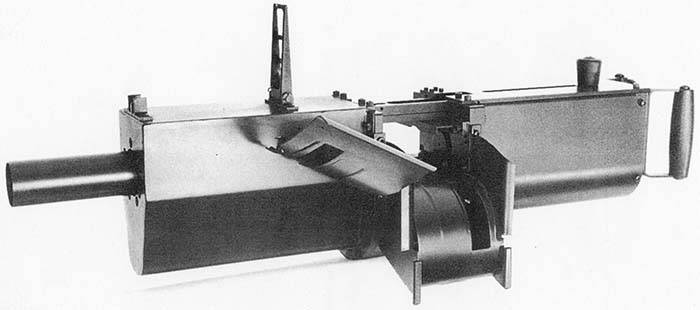
Grenade launcher Mk 20 Mod 0 without extras. The weapon is cocked. Photo by Smallarmsreview.com
In August, the Naval Ordnance Systems Command, Naval Ordnance Systems Command, ordered the Naval Ordnance Station to develop a new automatic grenade launcher to equip patrol boats and other light watercraft. This product was considered as a replacement for the recently adopted Mk 1966 Mod 18. In accordance with the then existing project naming rules, the new grenade launcher was designated as the Mk 0 Mod 20. It should be noted that new modifications of this weapon, which could receive designations such as Mod 0 or Mod 1, have not been created.
The gunsmith engineers from Louisville, Henry Watson, George N. Chinn and William Shnetter, spent about nine months developing the new project. Already in May, 1967, they presented at once three versions of advanced weapons with full-fledged automation. Soon began the tests, the results of which was chosen the most successful sample. This version of the Mk 20 Mod 0 project was developed and, after minor improvements and improvements, was able to reach the next stages.
The winner of the internal competition was the version of the grenade launcher with automatic based on the roll-out of the barrel and the free gate. This model was supposed to use 40x46 mm R type shots from an M79 hand grenade launcher. Such shots gave a relatively powerful recoil impulse, and therefore, for the mechanisms to work properly, the designers had to use two types of automation at once, as well as, respectively, two sets of return springs and buffers.
Externally, the new Mk 20 Mod 0 was not similar to the existing American design of its class. It differed in smaller cross sections and more accurate appearance. Particularly strong was the contrast with the Mk 18 Mod 0, which it was intended to replace. In the context of comparison with the Mk 18 Mod 0, it can also be noted that there was almost no free space inside the receiver of the new grenade launcher, and almost all the internal volumes were occupied with various parts and devices. This fact, among others, also affected the compactness and ergonomics of the weapon.
NOS designers have placed all the main automation devices on the frame of the original design, which is covered from the outside with several metal covers. The latter gave the weapon a neat and even elegant appearance. The frame includes four vertical plates with various openings, as well as fixtures for different parts. Between themselves, they were connected by longitudinal metal elements. The two front plates were intended for the installation of the trunk and related parts, the two rear ones for the gate and its springs. Under the two central plates were fasteners for mounting a grenade launcher on the machine.
Light stamped covers should be installed over the frame. A casing with a hexagonal cross section was placed in front. The horseshoe detail covered the bottom of the mount for the machine. Shutter units covered with rectangular detail. A longitudinal groove for the cocking handle was provided in the cover of the rear casing.
In the front compartment of the receiver there was a movable barrel capable of moving along the longitudinal axis. A rifled barrel was used with a 40 caliber mm 13 inches long (330 mm). Directly on the barrel worn combat spring. Its front end rested against the plate-wall of the receiver, and its rear end - against the thickening of the breech breech. Under the barrel was a rod-thrust connecting it with the tape feed mechanism. On top of the bolt, the longitudinal thrust departed, on which the cocking handle was located.
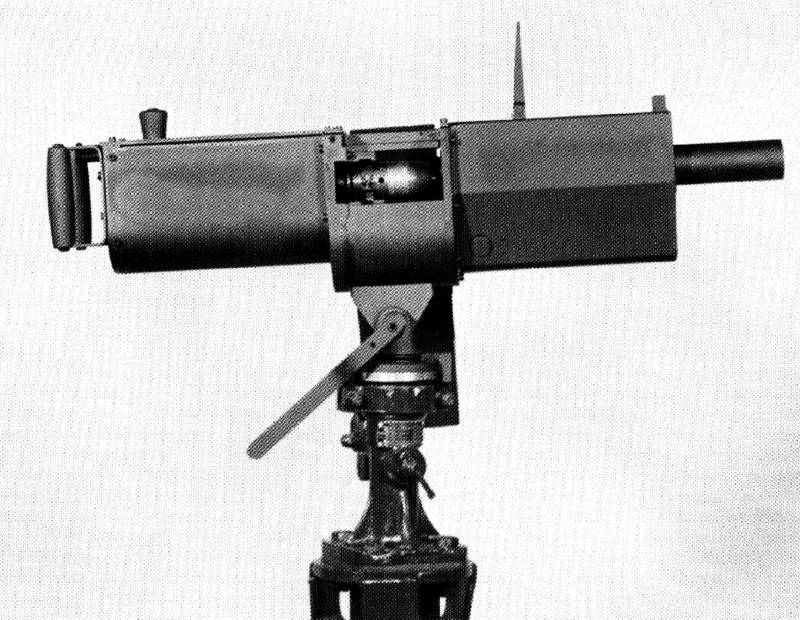
Right view. The grenade launcher is cocked, the grenade is ready for discharging. Photo from the book "The Machine Gun"
In the middle part of the weapon was the mechanism of ammunition. Receiving impulse from a moving barrel, he had to move the tape with the help of a pair of hooks, stretching it from left to right. Nearby was a spring-loaded feeder, necessary for the withdrawal of a shot on the line of disilane
The third vertical frame plate had a shutter hole. The shutter itself was made in the form of a massive rectangular block with a cylindrical protrusion on the front wall. He had a fixed drummer. On the sides of the bolt, holes were provided for several guide rods, which were fitted with return and buffer springs. Any means of coupling the bolt to the barrel during the shot were not used. At the same time they had a mechanical connection in the form of a thrust with the cocking handle, which ensured the reloading of the weapon.
The grenade launcher received a specific trigger. It included a sear that blocks the barrel in its extreme forward position, a control button and a thrust connecting them. The descent control button was located on the back wall of the weapon, and the sear had to be carried forward to the trunk. There was a fire interpreter who provided firing single or bursts. The Mk 20 Mod 0 project involved the use of an automatic fuse. This device turned off the descent and did not allow the trunk to move from the extreme forward position.
The grenade launcher's ammunition system used metal ribbons formed by narrow rings. After certain improvements, such a tape was used in a later project, the Mk 19, and still remains in operation with this weapon. Tape with grenades 40х46 mm R was proposed to be transported in metal boxes of various capacities. To properly feed the ribbon to the weapon, a special curved receiver tray was designed, located on the left wall of the receiver.
From the point of view of ergonomics, the automatic grenade launcher Mk 20 Mod 0 was similar to some machine guns of its own and earlier times. It was proposed to mount it on tripods or other installations, including various vehicles. Hold and fire control was carried out using a pair of vertical arms mounted on the rear wall of the weapon. Next to the right handle was located the fire control button.
The weapon was distinguished by high ballistics, associated with the characteristics of the ammunition and the small length of the barrel. In this regard, it received specific sights. On the front of the receiver was set a small unregulated front sight. At a short distance from it there was a folding lamellar rear sight with several holes, calculated for different firing range.
The automatic grenade launcher of the new model was similar in size to existing products. Its length was 31,2 inches (792 mm) with a width and height of about 9,5 inches (no more than 250 mm). Weight - 26 pounds or 11,8 kg. The mass of the entire grenade launcher system depended on the type of installation and ammunition. For example, a box with a ribbon on 24 grenades weighed about 9 kg. The initial speed of the grenade was 240 feet per second (73 m / s). Effective range of fire - 350-400 m.
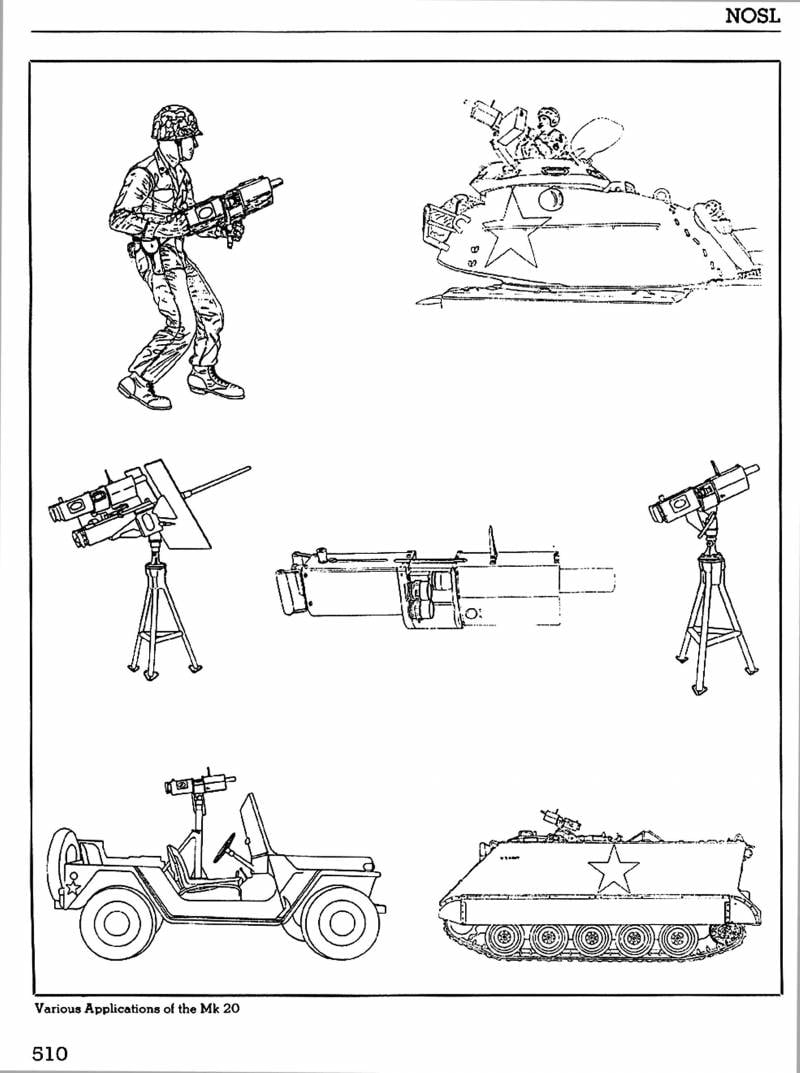
Different options for mounting and use of the Mk 20 Mod 0 grenade launcher. Picture from the book "The Machine Gun"
While preparing the Mk 20 Mod 0 grenade launcher for firing, the fighter had to move the upper arm of the cocking forward. At the same time, the barrel shifted to the extreme forward position, squeezed the mainspring and was blocked in this position by the sear. Turning on the fuse, the shooter had to place a tape with shots in the receiver. Then it was possible to turn off the fuse, bring a weapon and press the trigger.
Pressing the button released the barrel, and that under the action of the spring began to move backwards. During the movement, the breech put on a grenade and dropping occurred. At the rearmost point, the barrel slightly shifted the grenade back, which led to the contact between the primer and the fixed drummer. Shot occurred. The grenade, moving along the bore and interacting with its rifling, slightly shifted the barrel forward and partially squeezed its spring. At the same time, the recoil impulse was transmitted through the sleeve to the shutter, which started the rollback. Once in the rearmost position, the bolt squeezed its return springs, and also hooked on the control of the barrel. Under the action of springs, the bolt moved forward, simultaneously pushing the barrel in the same direction. At that moment, when the bolt turned out to be in its initial position, the barrel went to the most forward position and became a platoon. Simultaneously with these operations, the ribbon was pulled: the empty cartridge in the ribbon went to the right, and its place was occupied by a new ammunition. The weapon was ready for the next shot. Such automation allowed to do up to 275 shots per minute.
The first tests of the experienced Mk 20 Mod 0 took place in the 1967 year, but then the design work was continued. For several reasons, the next stage of inspections in the interests of the army passed only in 1970. At this time, a modified version of the grenade launcher, distinguished by several small but significant innovations, was brought to the test site. Due to such changes, it was possible to increase the reliability of the weapon and exceed the requirements of the customer.
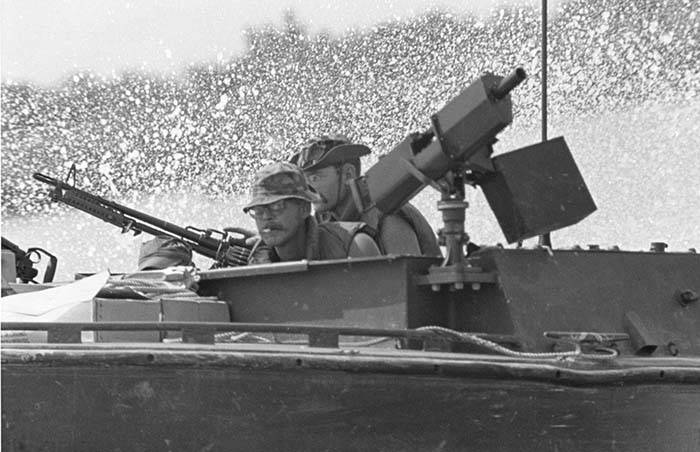
Automatic grenade launcher on a patrol boat. Photo by Smallarmsreview.com
In the same year, a new grenade launcher was recommended for adoption and mass production. Soon, the US naval forces received the first serial Mk 20 Mod 0, intended for installation on patrol boats and other similar vessels. Some of these weapons were planned to be mounted on the floating craft of the new construction, while other samples were intended to replace existing weapons. The Mk 20 Mod 0 was initially considered as a replacement for the Mk 18 Mod 0, and the rearmament of the combat units began at the earliest opportunity.
Showing approximately the same characteristics, the two automatic grenade launchers had significant technical and operational differences. Thus, a newer product with the same dimensions had more convenient forms. In addition, it was less difficult to use, since the needle did not have to hold one handle and rotate the other. The presence of full-fledged automatics removed the load from the shooter and therefore allowed to maintain the desired rate of fire for an arbitrarily long time. Against the background of its predecessor, the new Mk 20 Mod 0 grenade launcher looked very well.
Appearing in the late sixties, a new grenade launcher could not get into Vietnam. He had obvious advantages over the already used weapons, and therefore quickly received the best reviews. Crews of patrol boats or land combat vehicles before could have fired at the enemy with fragmentation grenades, but now this process was less laborious and more efficient. According to various sources, during the Vietnam War, the American army simultaneously had several hundred Mk 20 Mod 0 grenade launchers in service.
It should be noted that by the time of the launch of mass production of the Mk 20 Mod 0 products, the US armed forces already had another automatic grenade launcher, which also showed high performance. Two years earlier, entered into service Mk 19, also equipped with full-fledged automation. For some time, several weapon models were exploited in parallel, but later the army made its choice. In terms of technical, combat and operational characteristics, the Mk 19 was considered the best automatic grenade launcher.
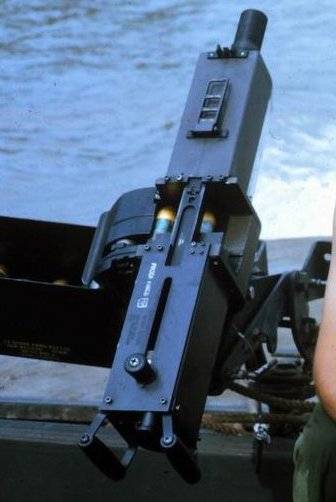
Grenade launcher on the boat, view from the arrow. Photo Guns.wikia.com
Such conclusions affected the release of other weapons. Production of automatic grenade launchers of the Mk 20 Mod 0 type was stopped in April 1971 of the year - approximately one year after the start. During this time, the army transferred no more than 1080-1100 weapons. It remained in service and was used until the mid-seventies, when it was completely replaced by the more successful Mk 19.
The Mk 20 Mod 0 automatic grenade launcher, developed by the Station of Naval Armaments in Louisville, was a very successful weapon, especially against the background of previous samples of its class. However, he was never able to get a big spread and take his place in the army. Due to some difficulties of one kind or another, the process of finishing and testing was delayed, and the grenade launcher was put into service only in the 1970 year - two years later than its main competitor, the Mk 19. During this time, the industry managed to manufacture and transfer to the customer significant quantities of Mk 19, as a result of which it quickly became the main US automatic grenade launcher.
Having no radical advantages over the competitor, the Mk 20 Mod 0, which entered the troops much later, could not press it and take the desired place. As a result, after a few years the army chose to leave in service a massive and well mastered Mk 19, and other types of products should be written off. Nevertheless, despite this outcome, the Mk 20 Mod 0 project contributed to the development of US automatic grenade launchers and left a certain mark on the stories.
Based on:
http://smallarmsreview.com/
http://warboats.org/
http://guns.wikia.com/
http://weaponland.ru/
Chinn GM The Machine Gun, Vol. Five. 1987.
Karpenko A.V. Automatic grenade launchers - weapons of the XX century. M .: Zeihgauz, 2007.
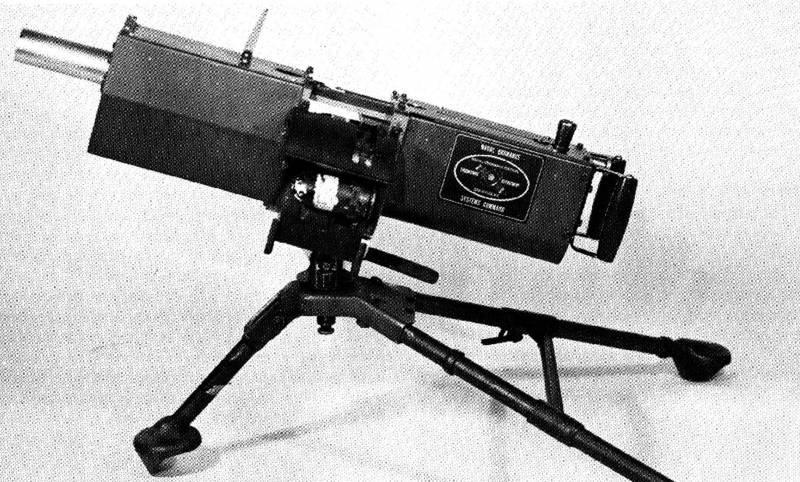
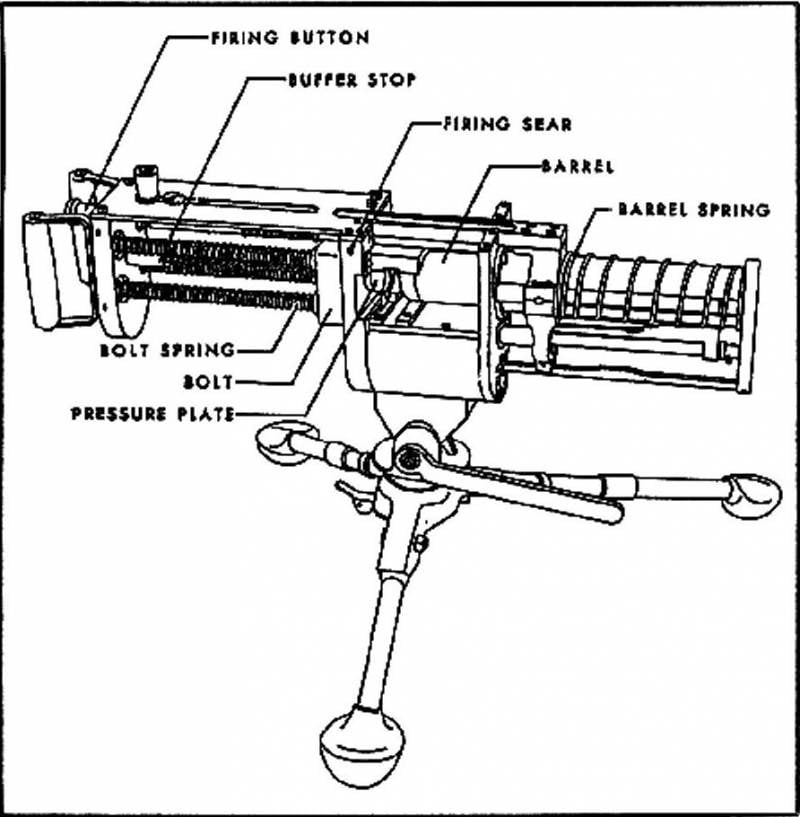
Information